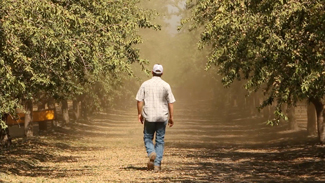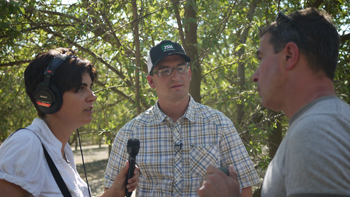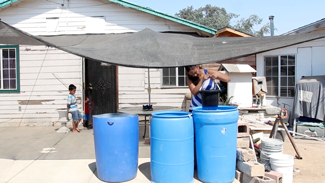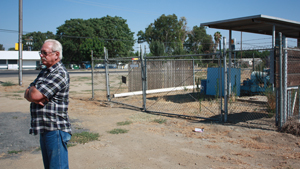California’s Central Valley: 'More Than Just Farmers on Tractors' [Video]
As we all know by now, California is in a serious state of drought. Some parts of the state are getting hit harder than others. The Central Valley is one of them.
We wanted to show what this long dry year has meant for one of the country’s richest farming areas. So, producer Suzie Racho and I headed down Highway 99 to meet up with The California Report’s Central Valley bureau chief, Sasha Khokha, who’s based in Fresno.
Our first stop was a cattle auction in the Tulare County town of Visalia. Agriculture is king here. Tulare County just passed Fresno as the top farm county in the nation. There are more cows than people in this county. Dairy alone is a $2 billion industry. But add in citrus, almonds, walnuts, pistachios and cotton, and the total is nearly $8 billion.

Almonds are particularly lucrative and Dominic Pitigliano is one of the larger growers in Tulare County. We met him in an almond orchard in Woodville. As we spoke, a large harvesting machine moved along the rows, gripping each trunk one a time and shaking it until the almonds rained down. You could easily think there was an earthquake.
Pitigliano is 33 years old — that’s young for a Central Valley farmer. He owns about 1,000 acres of almonds.
“It’s been a hard year with the drought and no water allocation,” he tells us. “We’ve had a lot of diseases in the trees because of the lack of water.”
To keep these trees alive, growers like Pitigliano are drilling down for water -- in some cases hundreds of feet below the surface. It’s like putting a huge straw in the ground.
“It’s not a race to the bottom because everybody doesn’t wanna see the valley dry up," Pitligano says. “Then again you don’t want to lose everything you’ve put your heart and soul into your whole life just disappear because you sat on your hands.”
While Pitigliano and other farmers are worried sick about the drought, we saw lots of orchards with acres of newly planted small trees. Pitliagno told us young almond and citrus trees use less water.
“So people have a wide range of tree ages,” he says. “They rip out high-using trees and plant young trees.” As for his own orchards, Pitliagno says, “I’m hedging my bets that in three years it’s going to be back to normal and I’ll be able to grow my crops again.”
Farmers here are drilling lots of new wells to keep the farms going during the drought. All that groundwater pumping is affecting everyone -- on the farm or off.
Gladys Colunga lives in the Tulare County farmworker town of Monson. It’s surrounded by orchards and vineyards.

“My husband came home one day from work, he took a perfectly good shower, and then I went to use the restroom. And when I flushed the toilet, nothing but dirt came out,” she recalls.
Her husband works the fields and his hours were cut this summer because of the drought, so the family has less money. On top of that, their well went dry.
The Colungas have six kids.
That’s a lot of laundry to do with no water. So they’re hauling water from neighbors and friends in barrels in the back of their pickup, and then scooping it into buckets to wash dishes.
They’re also trying to save enough water to run the swamp cooler that provides relief from the triple-digit heat.
“What’s upsetting is that just down the road there are orchards behind us drowning in water,” Colunga says.
“I understand that they need to get their crops as well, but then we’re a family, we have children and we need that water. I mean, we can live without a TV, we can live without cellphones, but we can’t live without water. We have the right to have that basic thing. It’s water.”

Sasha and I told Tulare County Supervisor Allen Ishida about the conversation we had with Gladys Colunga. We asked what he would say to people like her who can’t afford to drill their own wells, even though they own their property.
“The county does not have funds to help her,” Ishida says. “It’s the individual’s responsibility to take charge of the situation they’re in.”
His point: The government can’t use public funds to help private well owners. So families like Gladys Colunga’s are pretty much out of luck.
The long-term solution for communities like Monson may be to hook into a nearby town’s water system. But meanwhile, groundwater levels are dropping -- fast. Tulare County is issuing a record number of permits for people who want to drill wells, and Ishida says he knows that’s having an impact on the drinking water wells for nearby residents.
“At this point in time, it’s a property right that you have,” Ishida notes. “You can drill a well and take the water that you need without any regulations by us or the state of California.”
Ishida is also a citrus farmer. We met him in one of his neighbor’s orange groves that had been abandoned due to the drought. It looked like a forest of thousands of brown dead trees with shriveled-up oranges.
“I just hope someone doesn’t start a fire in here,” Ishida says. “I mean, all it takes is a match, and 40 acres are going to go up in flames.”
Ishida’s neighbors aren’t doing well because they have no groundwater. But his own orchards are OK. He bought river water from water contractors — at 10 times the normal price.
Water is like liquid gold in the Central Valley these days. And Ishida says he’s not sure he can afford that again next year. Still, he’s hopeful. “You need to be optimistic, no matter what business you’re in.”
It’s not just folks living here who have a lot at stake.
“People need to remember, this is not just the San Joaquin Valley,” Ishida warns. “This is happening throughout the state of California. We could have 100,000 wells or more go out by October throughout the state. I mean it’s everywhere.”

That’s exactly what worries people like Mike Clark. He runs the water system for the town of Poplar, which has a population of 2,500.
“It’s not going to do any good if all these towns dry up and we don’t have any water,” Clark says. “(Then) you’ve got nobody to work the fields, because they don’t live here anymore. So it’s kind of a double-edged blade.”
The average income in Poplar is about $13,000 per individual, he says. “I got residents that live in Poplar, if I raise the water rate by $5, they gotta go one day without eating.”
The town’s main well is straining to pull enough water this summer. Sometimes they’ve had to turn on a backup well contaminated with nitrates. Residents are being warned that the water’s not safe to drink or cook with — especially for babies and pregnant women.
To Mike Clark and others in towns like Poplar, it can seem like farmers are using as much water as they want.

“They can waste water all they want and nobody’s sayin’ nothin’,” Clark says.
The drought is starting to pit neighbor against neighbor — those with water and those without it. But the idea that farmers get too much of the water doesn’t sit well with growers here, including Dominic Pitigliano. He says critics aren’t seeing the whole picture.
“Did they grow the dinner they had last night?,” he asks. “They probably haven’t. Most people, they go to the store, buy everything they need for dinner that night, so they’re happy. So it’s hard for them to look at us bad when they’re taking advantage of everything we’ve given them.”
The drought is top of mind here — you hear it on talk radio, in cafes and restaurants. But one thing we heard repeatedly during our road trip is that the Central Valley is about much more than farmers on tractors.
To begin to grasp the complexity of life here, you have to do what we did. Get off the highway and meet some folks!